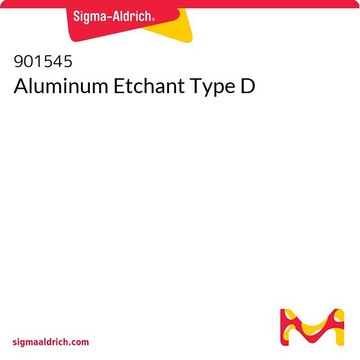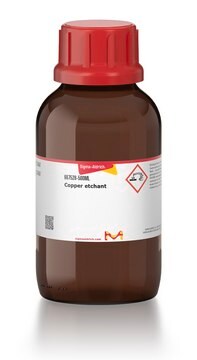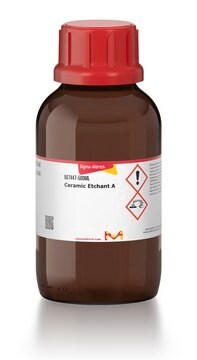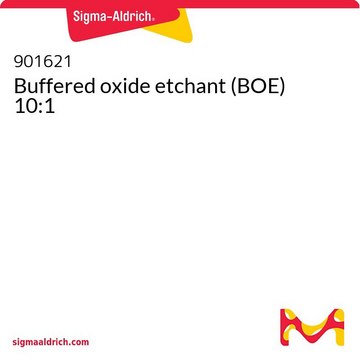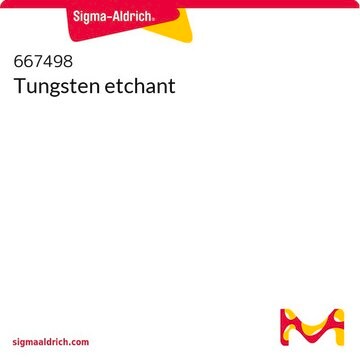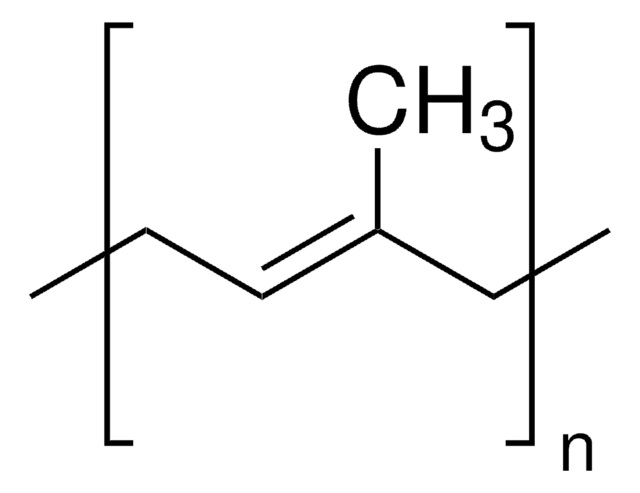901539
Aluminum Etchant Type A
Synonym(s):
Aluminum etching solution for use on silicon devices
About This Item
Recommended Products
form
liquid
General description
- Standard aluminum etchant for use on silicon devices and other microelectronic applications.
- Aluminum etchants are stable, non-toxic preparations used to etch aluminum metallizations on silicon devices and in integrated circuit applications. Aluminum contacts are defined, and interconnections are formed. These aluminum etchants, formulated with unique properties, easily overcome many of the difficulties experienced in aluminum etch processes.
- The aluminum metallization and etching process using photo-lithographic techniques is basic to semiconductor and microelectronic technology. Aluminum etchants are highly compatible with commercial photoresists and permit delineation into high resolution patterns. Metal line width of 1 mil and separations less than 5 microns are feasible. High resolution is practical with these aluminum etchants because lifting of photoresist patterns does not occur and undercutting is minimized. Furthermore, the etchants do not attack silicon, silicon dioxide, silicon nitride or nichrome resistor films.
- Two aluminum etchants are offered for use in microelectronics. Type A is recommended for use on silicon devices. Type D is recommended for use on gallium arsenide and gallium phosphide devices to avoid attack of the etchant on the intermetallic compound. It is also recommended for etching aluminum metallizations on nichrome thin film resistors.
Application
- Aluminum metallizations up to 25,000 Å are vacuum deposited on the silicon slice, coated with a photoresist, and UV exposed using an appropriate photographic mask. The resist is developed to protect the aluminum where interconnections are desired. Then the unprotected areas of the aluminum are removed by etching with the aluminum etchant, followed by a water rinse.
- Etching time is dependent upon the etchant temperature and the aluminum film thickness. When etching thick aluminum films, a higher etch rate is required; thus a higher etchant temperature should be used. Likewise, for thinner aluminum films, slower etch rates are desired and a lower etchant temperature should be chosen.
- At a specific etchant temperature, the etching time is given by the following formula:
where Etch Rate at 25°C 30 Å/sec; at 40°C 80 Å/sec.
Features and Benefits
- Controlled etch rates
- Selective etching: will not attack SiO2 or Si3N4
- Offers high resolution with minimal undercutting
- Eliminates smut formation
- Economical; reusable
Signal Word
Danger
Hazard Statements
Precautionary Statements
Hazard Classifications
Acute Tox. 4 Oral - Eye Dam. 1 - Met. Corr. 1 - Skin Corr. 1
Supplementary Hazards
Storage Class Code
8A - Combustible corrosive hazardous materials
WGK
WGK 1
Flash Point(F)
Not applicable
Flash Point(C)
Not applicable
Regulatory Listings
Regulatory Listings are mainly provided for chemical products. Only limited information can be provided here for non-chemical products. No entry means none of the components are listed. It is the user’s obligation to ensure the safe and legal use of the product.
ISHL Indicated Name
Substances Subject to be Indicated Names
ISHL Notified Names
Substances Subject to be Notified Names
JAN Code
901539-500ML:4548173367293
901539-BULK:
901539-VAR:
Choose from one of the most recent versions:
Certificates of Analysis (COA)
Don't see the Right Version?
If you require a particular version, you can look up a specific certificate by the Lot or Batch number.
Already Own This Product?
Find documentation for the products that you have recently purchased in the Document Library.
Customers Also Viewed
Our team of scientists has experience in all areas of research including Life Science, Material Science, Chemical Synthesis, Chromatography, Analytical and many others.
Contact Technical Service